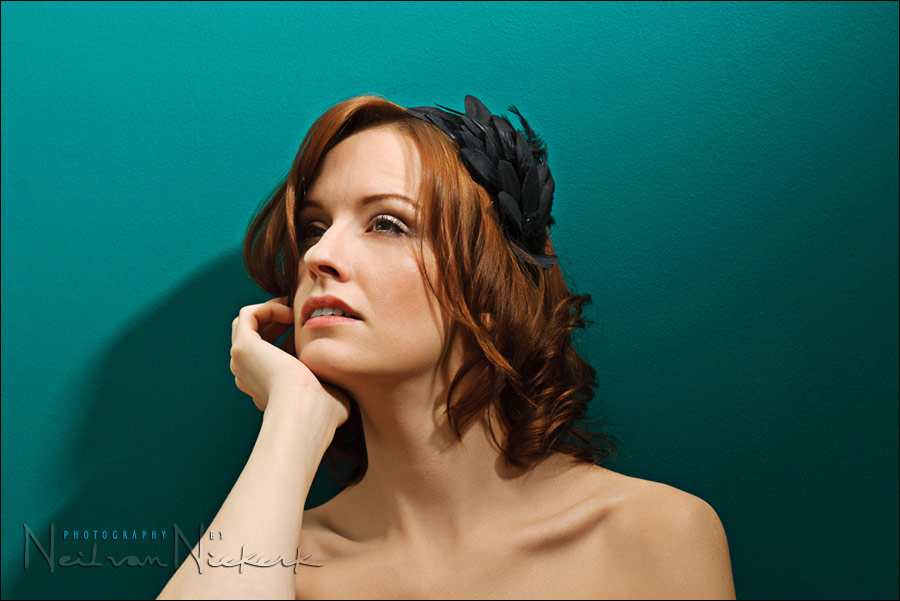
using a small softbox for lighting an intimate / boudoir photo session
With intimate photo sessions, I use a number ways of lighting my subject. This helps to bring some variety to the images. It helps mixing things up a bit by not using just one specific way to light the session.
While I sometimes use a softbox, the medium sized softboxes (or the 24″ x 24″ softboxes) are just a little too big to swing around in a small room. With a recent on-location photo session in New York, I used the Lastolite 8.6″ Ezybox (B&H) a few times. I took it along on that photo session because it is so compact.
So when I arranged with a model, Carly Erin, to do another photo session, I instantly thought of taking this smaller softbox along. With the previous intimate photo session with Carly, I used bounce flash and tungsten light (the Lowel ID-light). But this time I decided to predominantly use this new small softbox. And I really liked the results …
(before clicking on the ‘more’ link,
be aware that the rest of this post has images with some nudity.)
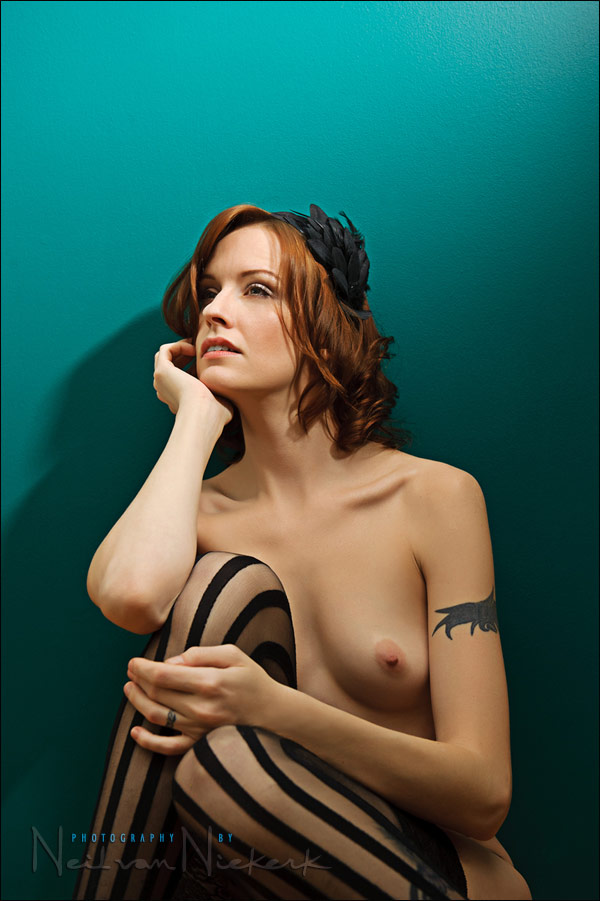
Here is the full image shown at the top.
The first thing to notice here is the fall-off in light. This is due to the small size of the softbox .. but also not due to the small size of the softbox. Let me explain …
By feathering the light from the softbox upwards. My assistant was holding the softbox up in her hand. So by instructing Jessica to move the softbox in an upwards arc, we got the edge of the light from the softbox to fall on Carly’s face. And that is where that specific shadow comes from. The light gently illuminating Carly’s body lower down, is from the light bouncing off the ceiling and walls.
Therefore the light you see in that image, is a mixture of light from the softbox and indirect light from the bounced light. And it works beautifully. While I did this on purpose, with an idea of what I wanted, the feedback from the camera’s preview was essential in getting to the specific result. And I really like the result.
camera settings: 1/60 @ f5.6 @ 500 ISO; flash set to TTL.
My on-camera speedlight was set to Master, but with its own output disabled. This Master speedlight tripped the Slaved speedlight that was in the Lastolite 8.6″ Ezybox (B&H).
So the result here was due to the small softbox … since the spread of light isn’t as wide as that of a medium softbox, it was easier to feather the light like this and thereby force this kind of light fall-off. So the light fall-off isn’t a negative side-effect of the softbox being small. The light fall-off was intentional, and the small size of the softbox facilitated this.
equipment used for this photo:
Nikon D3; Nikon 24-70mm f2.8 AF-S (B&H) … used at 50mm
Nikon SB-900 (B&H); Nikon SD-9 battery pack (B&H)
Lastolite Ezybox speed-lite 8.6″ (B&H)
Yes, that was shot at the 50mm focal length, but isn’t a close-up head-shott.
![]()
With this image, the softbox was used directly on Carly:

I liked the way the edge of a table to the left-hand side of the image, caused that shadow. But what you see there, isn’t quite how it looked. Here is the actual image:
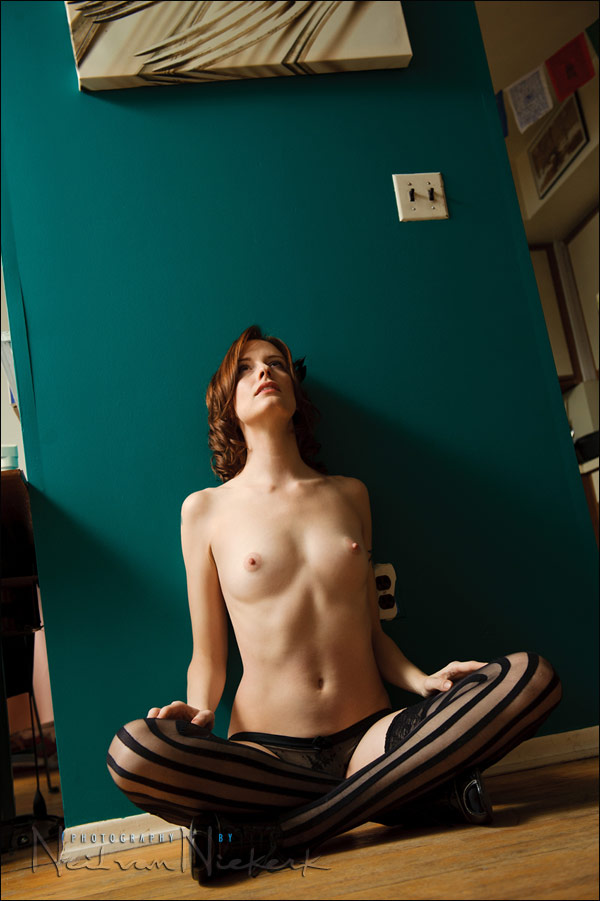
We were in the living room area, with Carly sitting in the passageway leading to the bedrooms. The kitchen behind her. There just wasn’t the working space. So with some use of the Clone Tool and Healing brush, and a lot of use of the Content-Aware Fill tool of Photoshop CS5, I was able to make the green wall much larger. So now there is space. The Content-Aware Tool is certainly a great addition to Photoshop, but the person who really should win the Nobel Prize there at Adobe, is the genius that came up with the Healing Tool.
equipment used for this photo:
Nikon D3; Nikon 24-70mm f2.8 AF-S (B&H) … used at 40mm
Nikon SB-900 (B&H); Nikon SD-9 battery pack (B&H)
Lastolite Ezybox speed-lite 8.6″ (B&H)
I was lying on my side on the floor to get that angle.
![]()
With this image, I really liked how the light from the softbox looked like light streaming in through the window, perhaps with the curtains half-open.
camera settings: 1/100 @ f2.8 @ 800 ISO; flash set to TTL at -1 FEC
My on-camera speedlight was set to Master, but with its own output disabled. This Master speedlight tripped the Slaved speedlight that was in the Lastolite 8.6″ Ezybox (B&H). With the light on the bookshelf on the background, this image really does have a sunshine-y look to it with the light from the softbox. My choice of settings were such to let the background blow out a little bit by over-exposing it. It also helps that it is so out of focus.
Equipment used for this photo:
Nikon D3; Nikon 70-200mm f2.8 AF-S II (B&H) .. used at 125mm
Nikon SB-900 (B&H); Nikon SD-9 battery pack (B&H)
Lastolite Ezybox speed-lite 8.6? (B&H)
Here is the image with the flash disabled, so you can clearly see what the softbox lit up.
Then, just to change things up, I asked Jessica to point the sotbox into the room to bounce the flash. I pulled down the FEC to -2 EV so that the light from the flash is just a kind of fill light on her, retaining the mood.
Here is the pull-back shot:
While Jessica made the shoot much easier in that I could do minute adjustments to the position of the light without getting up, this small softbox would’ve been ideal on a compact light-stand.
![]()
One final image, this time just with available light and bounce flash (with the black foamie thing) to fill in the shadows.
camera settings: 1/250 @ f5.6 @ 800 ISO; flash set to TTL at 0 FEC
equipment used for this photo:
Nikon D3; Nikon 24-70mm f2.8 AF-S (B&H) … used at 50mm
Nikon SB-900 (B&H); Nikon SD-9 battery pack (B&H)
![]()
All the photos here were retouched similar to described in the article on retouching and post-processing for portraits.
![]()
Final comment about the softbox:
When I bought the Lastolite 8.6″ Ezybox (B&H), I thought it seemed like it might be useful at some point somewhere. But after using it during this photo session, I can see that it will be an essential part of my lighting gear I take with me on photo shoots. I really do like the results.
One thing that helped with some images where we bounced the light from the softbox, was to remove the front baffle, and this gave us more control about the direction we were bouncing the flash towards. The edges of the softbox then flagged the light to an extent, giving us more control over the direction of light.
related links
- minimilast lighting for an intimate photo session (w/ Carly Erin)
- lighting for boudoir photo sessions
- Yes, that was shot at the 50mm focal length, but isn’t a close-up head-shot
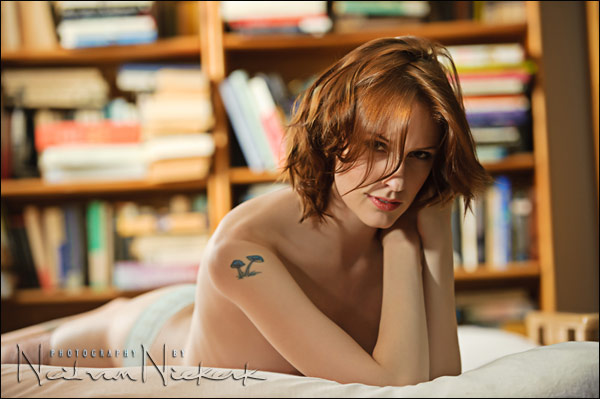
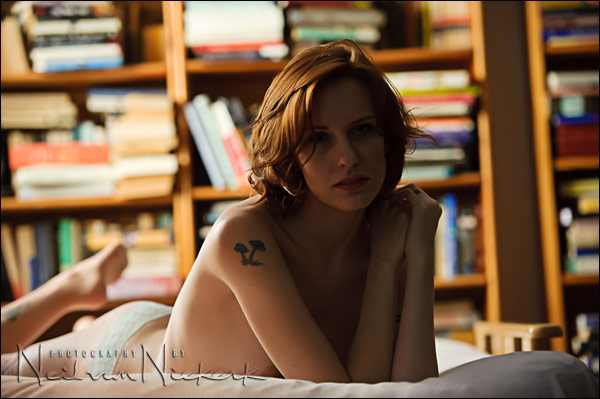


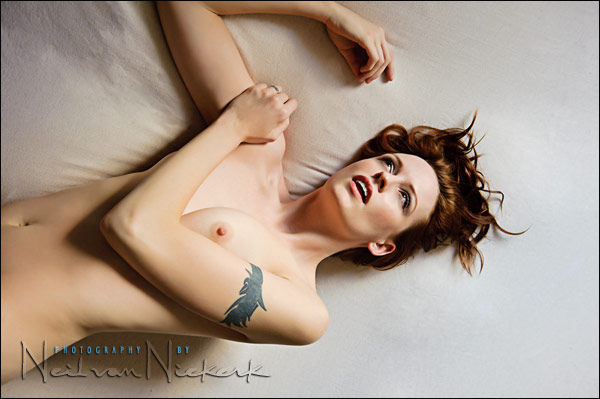
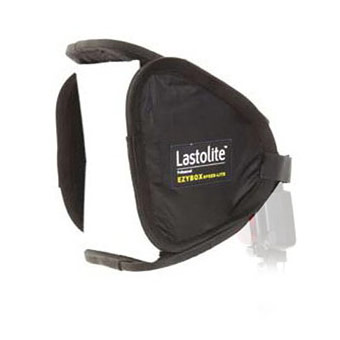
Neil,
When the 8.6″ Ezybox is pointed at the subject, is it generally positioned closer to the subject compared to the 24″ x 24″ Ezybox? I presume it would be positioned closer, because if it was too far away, it would end up being a point source which would create harsh flash.
Also, for tight spaces and when you don’t have an assistant, the 8.6″ Ezybox could be mounted on a Justin Clamp, and you could clamp it to a table edge or chair.
Very nice set of images. I think you show that it’s possible to get good results even with a very small softbox!
btw, its outrageous how much these companies charge for a 9″ softbox. $80 for that thing is a highway robbery!
no worries, there’s always a chinese knock-offs (and nearly as good) for fraction of a price off ebay and other places :)
Really fantastic photos Neil, I really wish I could achieve the combination of beautiful light, great posing, interesting composition – with the ‘correct’ exposure (both ambient and flash) without distorting or disfiguring your model by using the wrong focal length lens at the wrong distance whilst using the appropriate aperture for the required depth of field (and bokkeh) – oh and they’re sharp!
I know what I ‘should’ be doing but my brain tends to melt a bit with all that to remember – and if I remember most of it, my model ends up looking like she’s just sneezed!
Hi Neil.
Great post, thank you.
Just one question – how do you disable output on your master flash so it doesn’t affect your final image?
Thank You.
Neil,
Great post – love the use of this small softbox.
Any idea how it compares with the Lumiquest LTP Softbox?
It seems to be of a similar size, but a bit more portable:
https://lumiquest.com
Best, P:)
Neil, did you remove or there was non color cast from the green wall on the first four images?
When I try to take some close-to colored wall pictures, I almost all the time deal with color cast.
Otherwise another great post. :)
nice.. Love Carly too from the old AZ Shoots fame. Agree about buying anything Chinese these days.. They are waging a mercantile war against the USA and we just keep buying and buying..
Neil:
Thanks for the reply. I will need to force myself to experiment with this Lastolite 8.6″ and get accustomed to its light falloff characteristics. I’m surprised that even small softboxes can be positioned far away before becoming point sources. Good to know.
Pasquier:
The Lastolite Ezybox is 8.6″ by 8.6″ and folds into triangular flat shape for portable carrying. The Lumiquest softbox you cited is 10″ x 14″, so it’s bigger than the Ezybox. I don’t think it is as portable.
Alex:
If you have a Nikon camera that has a built-flash, there should be a “Commander Mode” in the Custom Settings menu. Once there, you’ll see something like this:
Built-in Flash
Group A
Group B
Group C
Set the Built-in flash to — under Mode. That disables its output flash and only generates a preflash to the remote flashes.
Consult your manual.
If you are using a Nikon speedlight (anything other than a SB-600), you can go to its LCD menu in the speedlight display and do the same thing. Also, consult your manual.
While I’m impressed with your lighting as usual, I’m even more impressed when I see the pull-back images. You’re getting wonderful images in tight quarters that most people, including me, would generally pass over as unsuitable.
Since I don’t want this discussion to go south either, I would just like to say;
Some people give and some people take, but the important thing is which way do you (the person reading this) want the human race to go!
Neil thanks for only giving!
The Honl 8″ Traveler is pretty good also for such close up work and it costs a bit less than the Ezybox for whoever is interested.
As for Chinese knockoffs I do have a ball head and a tripod both painstakingly copied after Manfrotto up for anyone who wants them. Ballhead is difficult to adjust and the tripod broke the angle step adjustment of one of its legs on its third use. When they first came in the door they looked solid and all but the materials in key areas are either not good enough or not machined properly. No more Chinese stuff for THIS photographer folks.
Finally, most people who steal software cannot create something original to save their lives because if they could, they would definitely not like to have it stolen and used by anyone else, but that’s another story for another posting.
Cheers!
Bogdan
Yep, you’re right Neil. You have to spend a bit of time when you put the diffuser on to “round” it up. Its overall frontal area is also around one fifth or so smaller than the Ezybox. I do use David Honl’s stuff quite a bit so for me it’s convenient to use… However one of the reasons I hate your blog is the fact you’re mostly right on equipment choices :-). Sooner or later (probably sooner I guess) I’ll bite the bullet and get the Ezy… :-)
Great pictures as usual Neil (with the exception of the last one… she looks umm… dead… in that… sorry… just me…)
Cheers!
Bogdan
The Expression on Jessica’s face is absolutely Priceless!
Hi Neil, what are your thoughts on this little softbox used outdoors? I thought it might be good as an on-camera softbox for some fill light, but then I’m thinking the light loss is probably around 3stops so not worth it on a sunny day.
I first noticed the new small Lastolite Ez box 8.6 x 8.6 being used by Joe Mcnally as an off camera flash in his blog from his current Asian trip. It caught my attention and I contacted you asking for information on this new Lastolite product. You mentioned that you had just written about it in your latest blog.I can’t believe I missed it as I am addicted to your frequent blogs and I go to PLANET NEIL as soon as I turn on my computer. What great coverage . Thanks a million. I immediately ordred it from B&H and plan to use it in Florida mid Feb. at a Rolando Gomez workshop in Palm Beach.
Neil,
So there are no issues with using the softbox and it blocking the wireless lens on the flash? I’m using Canon, but I’m guessing the technology is similar. I’d love to get one of these to use for wedding work also, but I don’t want to lose the e-ttl ability.
Mike
Mike,
On Nikon speedlights, the optical sensor that reads the TTL pre-flash from the master is on the side. The Lastolite Ezybox strap themselves on the flash head, so they do not block this sensor. All I have to do is make sure the sensor is facing the general direction of the master speedlight, since TTL technology is line-of-sight (i.e. if I can’t see the remote speedlights, they probably won’t receive the TTL pre-flash signal).
Neil,
Nice pictures! Your article changed my view on small size softbox. I need try it later.
As to the Chinese knock-offs, agree with you. I do suffer from them too. Sometimes I buy stuff from the US with help of friends. We just need years, maybe generations, to learn and improve the entire environment, changing the overall mindset of business, focusing on R&D and CREATing things.
@Ed Wilson
Don’t break your plate after finishing your meal, you still got to need it. I accepted all your opinions on Chinese knock-offs, but no further more. I doubt you could stop buying anything Chinese made. Think about it, you may end up with doing almost everything on your own. You even can’t triger your flashs because the cords are also made in China.
Globalization and outsourcing are NOT invented by Chinese, we’re not that smart as you do, which could be one of the reasons why Chinese labor cost is lower than yours. Be reasonable, man. Stop complaining about and benefiting from Chinese products at the same time. We’re inter-dependant. I’m here to learn, so let’s focus on photography, OK?
Neil – –
I’m new here (from digitalprotalk.com). What method and/or gadget do you use to check white balance throughout a shoot?
Many Thanks!
— Kent O.
Neil,
How does this softbox compare to a video light? Seems similar in concept (small, directed light source) for a lot cheaper.
Steve
Neil,
Is it a good idea to use this small softbox in a place where there is nothing to bounce flash, for examplein a big church during a wedding? Or do you prefer to use a omnibounce in this kind of situation?
Thank you Neil. Do you think the small softbox will spread the light wide enough when photographing a wedding. Let’s asume I have to make some pictures in the churg with 28 mm or so, would it still be better than a omnibounce?
Nice set and interesting info.
On this photo (my favorite) :
If I understand correctly, the softbox was pointing to the ceiling, so you are bouncing from the ceiling. I’m asking this because here face is filled-in nicely. Is it possible that the white sheets were bouncing the light back to her face?
Thanks Neil.